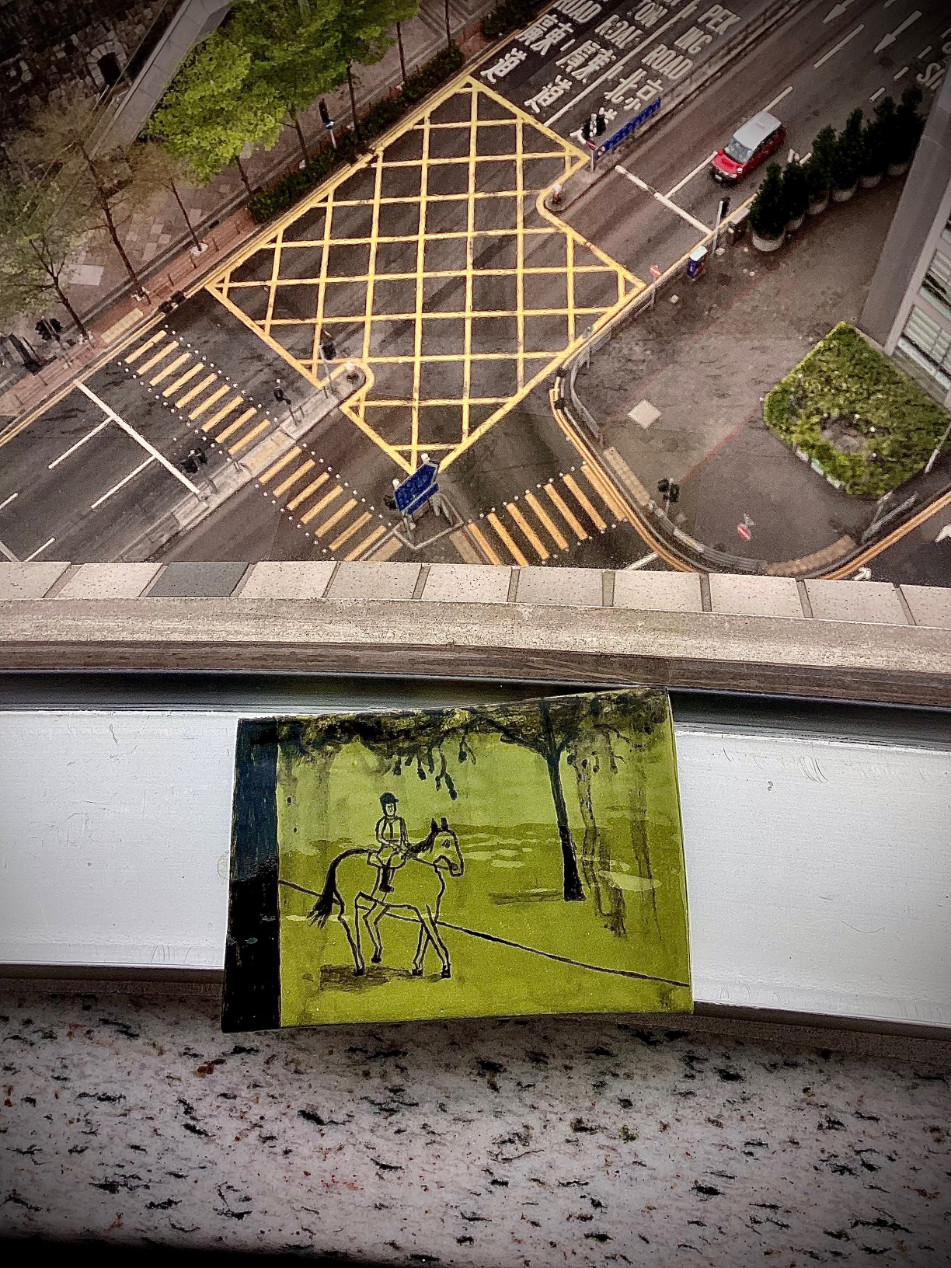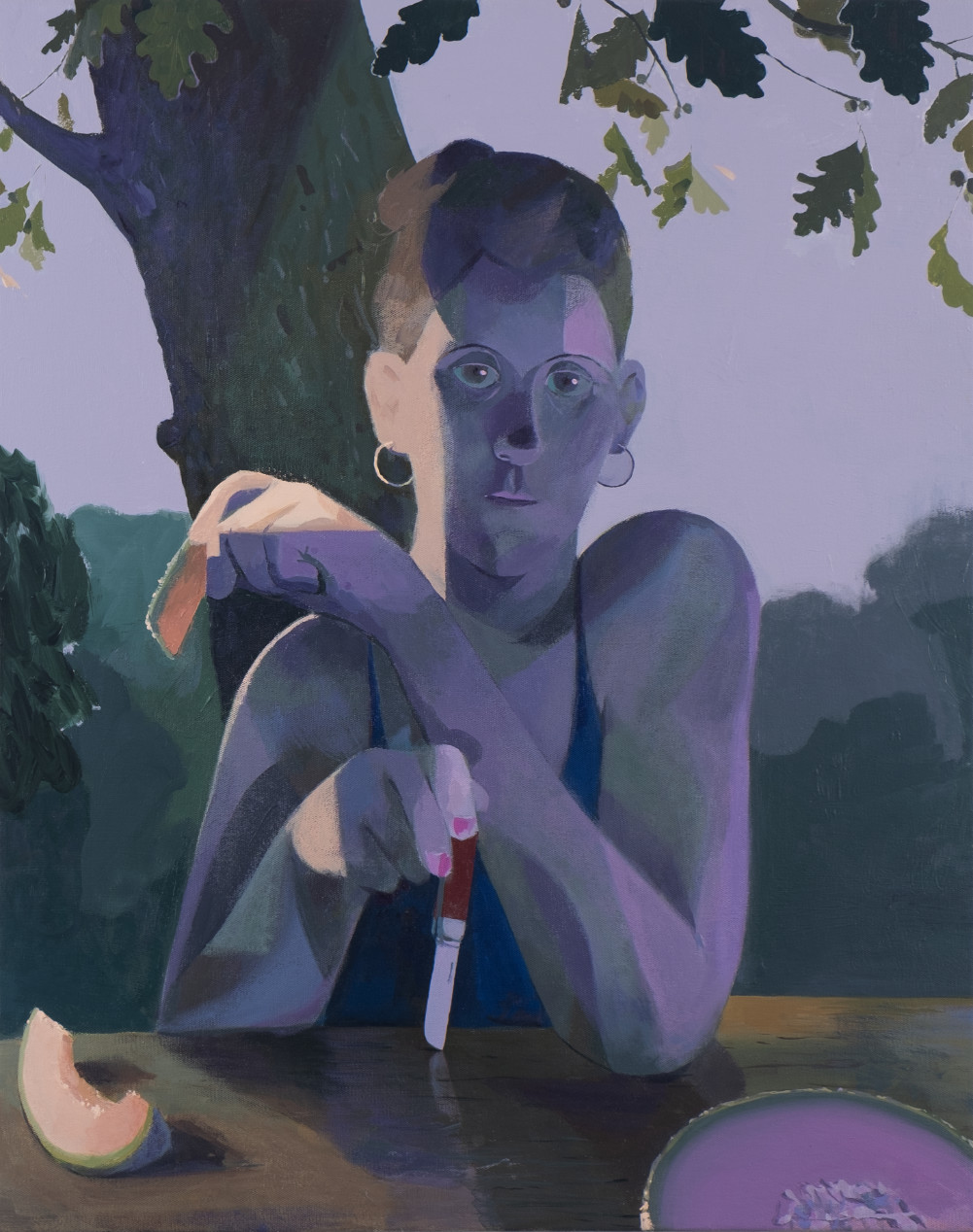exhibitions
Dublin
Noel McKenna
to wink at the cat

London
Matt Bollinger
halftime

Matt Bollinger
halftime
9 May - 29 June 2024
halftime, of what?
If Matt Bollinger’s previous exhibition for mother’s tankstation | Dublin, Off Peak [i], suggested the necessity of research regarding the etiquette or socio-politics behind the timetabling of bus and train tickets, the current body of work on show at mother’s tankstation | London, encourages a similar itch-to-scratch-factor, regarding time intervals in sporting fixtures… Do we bring sandwiches or buy beer and snacks onsite? For starters, what is the correct semantic form, “halftime”, “half-time” and/or half time? Apparently all valid, equally linguistically acceptable, but with the only difference being (as far as I can see) “a kind-of state of mind”, in relation to the ideas of the late Hungarian-American psychologist, Mihály Csikszentmihályi, regarding “Flow State” and hyperfocus. Flow in positive psychology, also known colloquially as being “in the zone”, is the mental state in which a person performing some activity is so fully immersed in a feeling of energised focus, full involvement, that it results in a transformation in the sense of time. Amongst other things, flow is employed as a coping strategy for stress and anxiety when productively pursuing a form of leisure that matches one’s skill set. Hence “halftime” emotionally continues engagement more than “half time”, and positively, rather than negatively, privileges the enforced pause between battle states[ii]. Even if we might be unfamiliar with Csikszentmihályi’s name, we will all be unwittingly familiar with his ideas and the lexicon of sports analogies, metaphors and stock phraseology derived from his work in performance psychology, that has subsequently, (almost on a comparative level to Shakespeare) entered the popular domain since the 1970s.
If we are all good with that, and as the theories of flow suggests, we can now “…focus on the task at hand”[iii], as Matt Bollinger ambiguously messes with the subtleties of this close-focus detail, by using one form for the exhibition title, (consciously all lower case); halftime, and another for the title of the large-scale painting, Half Time, that does a considerable amount of the exhibition’s heavy lifting. We are left to pick the bones and figure out intent, park the brain or keep it ticking.
Using the stay in the zone version, halftime; we have to ask if the best is over or worse to come – is that the same thing?[iv] Do we aggress or defend? Maybe it’s a momentary, revelatory, flash of mortality at a temporal landmark, a half-way-sort-of-crises, or a too close for comfort encounter with mortality: A metaphorical speeding vehicle in abject proximity to the metaphysical rocky edge of a mountainous ravine. Long way down, [stretching a hyperbole] let’s push on regardless…the echo of the tumbling yell curdles the blood, as we/they plummet thousands of feet to our probable death/s. Way too dramatic, and almost certainly none of the above, rather, it’s just the middle of any ordinary day, just like any other, somewhere between boredom and frustration. Given the exacting and arguable unique focus of Matt Bollinger’s work towards the neglected, troubled, heart of middle America, perhaps it’s half time between Democrats and Republicans (blue vs. red = purple). A tea[party] and biscuit break in a protracted Congress budget battle, or a hiatus in the Supreme Court’s deliberations on presidential immunity? Maybe it’s merely the multi-million-dollar Super Bowl intermission ads. Which or whatever, things are evidently poised on a knife-edge, a careful balancing act between pros and cons. Even odds on a both-ways bet. That one is the same thing. Tomato, tomatoe. (Right?) Ironically, one of the significant criticisms of ‘Flow’ theory is “overthinking”, or should that be over-thinking?
With a burden of doubt deliberately planted by the artist, it’s only natural to start a search for clues, sifting through the seven paintings constituting Bollinger’s tight selection of works for his second London exhibition with mother’s tankstation, duly entitled ’halftime’; if you hadn’t already got that one.
Feel the room, sense the atmosphere, after all nothing is for nothing in Bollinger’s work we discover: Although the greater construct of his project, through the paintings, drawings and animations, is conceptually founded upon the fictional town of Holmes, Missouri, complete with the recurring appearances of its smallish population, we find that the artist also piquantly peppers his paintings [say that fast] with meta-actual, super-specific-Iowa/Missouri-detailing. Hence, I have just lost half an hour of my life, as well as heavily loading my Google cookies quota, looking for the particular US college football team under reference in the (miesterwerk)[v] painting that both dominates the gallery’s back wall and (sort-of) bears aloft the exhibition’s title. The football player (in the zone) seated foursquare in the locker room of Half Time, wearing purple and gold, with a lion rampant, as a crest, graphically depicted on the changing room wall[vi], is about to have his knee strapped – some battling over, more battling to do. Teammate to stage right, not looking so cheery – dejected rather than elated, the same goes for the one standing behind[vii]. So, signs are ominous? The teammate standing stage left, looks side-eyed, at the one stage right, who is looking equally furtively, towards the knee-strapping activity of the coach, who is looking entirely out of the painting, (a whole other zone), towards the viewer. Unfocused on a specific task that should require full involvement, aside from his metaphysical exteriority, he is simply just not exuding the required “positive psychology”… Aggress or defend, pour everything into it and/or risk trailing more, the game is already gone… “Well done guys! Any other team would have lost by at least double!” Perhaps another way of looking at halftime, is time bisected, analytically stilled, a form of out of body experience.
Apart from the interior scene of the changing room, all the other works in the exhibition are situated outdoors, at least the weather is holding… but there are some perilous-looking skies. Bollinger’s palette favours the dramatically filmic effects of mid-western, late afternoon dirty-sunlight refracted into a particle-laden atmosphere, often beautifully blocked-out into constructivist painterly parcels. Similarly, Matt Bollinger’s recent solo presentation for Art Basel Miami Beach, Nova, swept through a tone-scape of perfectly nasty to pretty, in a pollution heavy manner, pinks and blues, to yellows, reds, back to purples and blue, while the gaze of every single protagonist unsettlingly froze upon the viewer.[viii] We, not they, were alone, outsiders in the cold, chilled by the collective dead-eye. Once again, stand in the ‘hot’ spot in the London gallery space and every eye fixes you with a frigid dart direct to the soul.
Returning to both knife-edges and pregnant skies, the confrontationally direct gaze, as well as the glint of the angled ‘Army Knife’ in Bollinger’s like-titled painting also augers ill. The innocent side of the story… it’s a picnic [!] and the distinctively red-handled implement is super-handy for neatly slicing up cantaloupe. The ‘look’ says otherwise. Honestly your Supreme worship… furthermore, we have two guys in ‘Fracture’, arguably one of Bollinger’s most sinister and purely chilling works to date, also staring directly at us. The main protagonist beautifully caught in a pool of red/orange light across the face, sports an expression somewhere between doubt and open hostility. The countenance of his companion, tucked inside the relatively anonymous safety of the car, on which the first leans, is even more suspicious (directly of us, that is – a “you looking at me” sort-of unspoken challenge, but probably less polite). The cigarette, or joint probably – given Bollinger’s exact rendering of both the form of said suspicious item and the pose of the fracture-bearing-smoker – is about to burn his fingers. Half time on a self-inflicted wound.
Across the room from each other, better and by implication, worse halves, cohabit. Bollinger has mirrored and reversed the form of a male grouping from ‘Tailgate’, where men in work gear, fish beers from a cooler on the back of a truck. In the companion work, ‘Better half’, ‘the women’ are caught, as if by surprise, in mid-diaper change. Both paintings literally catch each other in their collective gaze. The brilliance of Bollinger, or at least one of them, is that his paintings are entirely free from any sort of judgement or commentary, they just look, so intently and completely absorbed in what they are doing (or frequently not doing), that time parts and stops. The army knife stays implanted in the picnic table, the joint never burns the fingers, the football team never wins.
[i] Matt Bollinger, Off Peak, http://www.motherstankstation.com/exhibition/off-peak/overview/
[ii] Flow: The psychology of Optimal Experience, Mihály Csikszentmihályi, Harper and Row, 1990.
[iii] Ibid.
[iv] Half empty, half full… six of one, a half-dozen of the other etc., etc.,
[v] Meisterwerk is a ‘neuter’ noun in German, we like that. Matt Bollinger makes, on average, about two paintings of this ungendered endeavour a year, i.e. large 198 x 244 cm group compositions. I also thought I would throw this in, as although born in Kansas city and now living and working in upstate New York, the Bollinger family uses the Alemannic (Swiss/Deutsch) pronunciation of the surname.
[vi] The popularity of the Lion Rampant, as a sporting metaphor, is quite astonishing, Grrr. It’s almost as common as the future/conditional/imperative clause in sports commentary: “if they get this, it will be the best touchdown ever… oh NO, they have dropped it!!!!” My prolonged, but ultimately futile, search shows at least four possible candidates for the gold and purple colours, so I’m going to have to email Matt to fact check anyhow, I may as well have asked outright in the first instance! Life lessons; a direct approach saves half the time… and leaves less of a trail.
[vii] It’s possibly worth a mention, that a conversation resulting at Matt’s first London show: http://www.motherstankstation.com/exhibition/collective-conscious/overview/, with a ‘famous’ art historian visiting the exhibition, who noted the absence of happy faces in Bollinger’s work, thence comparatively referred this back to the lack of smiles throughout the entirety of ‘social realism’. Given the complete nonappearance of happiness or apparent pleasure in Hopper, I thought it worth a further investigation, looking to the question as to where exactly one draws the ‘social realism’ determining line… there aren’t a lot of grins, smiley faces, etc,. in Caravaggio, Leonardo or Picasso, for the matter. Bugger-all in Courbet, Stanley Spencer, and on we go… what then is, particularises or characterises social realism? And how does it differ from the broader genre of narrative painting?
[viii] http://www.motherstankstation.com/exhibition/art-basel-miami-beach-2023-nova/